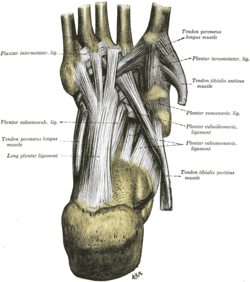| Plantar calcaneonavicular ligament | |
|---|---|
 Ligaments of the medial aspect of the foot. (Plantar calcaneonavicular ligament labeled at bottom center.) | |
 Ligaments of the sole of the foot, with the tendons of the peronæus longus, tibialis posterior and tibialis anterior muscles. (Plantar calcaneonavicular ligament labeled at right, second from the bottom.) | |
| Details | |
| From | calcaneus |
| To | navicular |
| Identifiers | |
| Latin | ligamentum calcaneonaviculare plantare |
| TA98 | A03.6.10.203 |
| TA2 | 1937 |
| FMA | 44254 |
| Anatomical terminology | |
The plantar calcaneonavicular ligament (also known as the spring ligament or spring ligament complex) is a complex of three ligaments on the underside of the foot that connect the calcaneus with the navicular bone.
YouTube Encyclopedic
-
1/3Views:6 44459332 241
-
Spring Ligament Complex MRI Anatomy
-
Spring ligament tear
-
Foot Anatomy Tutorial (Ligaments)
Transcription
Structure
The plantar calcaneonavicular ligamentous complex is a broad and thick band with three constituent ligaments. These connect the anterior margin of the sustentaculum tali of the calcaneus to the plantar surface of the navicular bone.[1][2] Its individual components are the:
- superomedial calcaneonavicular ligament.[2]
- medioplantar oblique ligament.[2]
- inferior calcaneonavicular ligament.[2]
These ligament components attach to different parts of the navicular bone.[2]
The dorsal or superomedial component of the ligament presents a fibrocartilaginous facet, lined by the synovial membrane, upon which a portion of the head of the talus rests. Its plantar surface, consisting of the intermedial and lateral ligaments, is supported by the tendon of the tibialis posterior; its medial border is blended with the forepart of the deltoid ligament of the ankle-joint.
Function
This ligamentous complex not only serves to connect the calcaneus and navicular bone, but supports the head of the talus, forming part of the articular cavity in which it is received. It helps to maintain the medial longitudinal arch of the foot.[1] By providing support to the head of the talus, it bears most of the body weight in a normally functioning foot.
Clinical significance
A sprain to the plantar calcaneonavicular ligament can result in flatfoot deformity, which can impair mobility.
See also
References
![]() This article incorporates text in the public domain from page 355 of the 20th edition of Gray's Anatomy (1918)
This article incorporates text in the public domain from page 355 of the 20th edition of Gray's Anatomy (1918)
- ^ a b Mojica, Miguel N.; Early, John S. (2019-01-01), Webster, Joseph B.; Murphy, Douglas P. (eds.), "19 - Foot Biomechanics", Atlas of Orthoses and Assistive Devices (Fifth Edition), Philadelphia: Elsevier, pp. 216–228.e1, doi:10.1016/b978-0-323-48323-0.00019-6, ISBN 978-0-323-48323-0, retrieved 2021-03-02
- ^ a b c d e Lui, Tun Hing (June 2016). "Endoscopic Repair of the Superficial Deltoid Ligament and Spring Ligament". Arthroscopy Techniques. 5 (3): e621–e625. doi:10.1016/j.eats.2016.02.004. ISSN 2212-6287. PMC 5021046. PMID 27656387.
External links
- lljoints at The Anatomy Lesson by Wesley Norman (Georgetown University) (soleoffootligaments)
- https://web.archive.org/web/20060507052103/http://www.ithaca.edu/faculty/lahr/LE2000/ankle%20pics/5medankle-new.jpg
